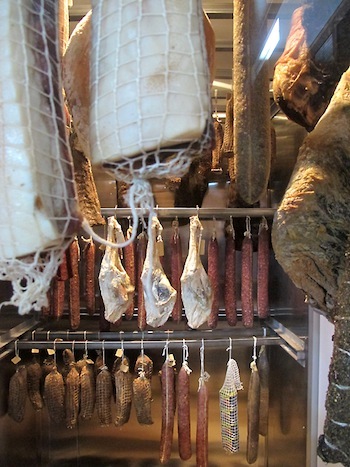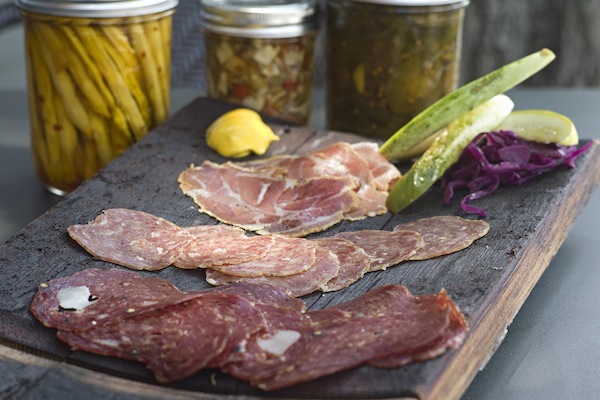After my research for the charcuterie article that appears in the current issue of My Table (“A Tour of Charcuterie,”) I can say I’ve had charcuterie all over Houston. What I found is that most restaurants serve cured meats that have been imported from other countries, such as Spain and Italy. Why?
 Well, one reason is the much-lauded qualities of these Old World meats. Prosciutto di San Daniele from Italy and jamón Iberico from Spain are highly prized and expensive. These countries have a much longer history of preserving meats than does the United States, and the process there is rigidly controlled by law and tradition.
Well, one reason is the much-lauded qualities of these Old World meats. Prosciutto di San Daniele from Italy and jamón Iberico from Spain are highly prized and expensive. These countries have a much longer history of preserving meats than does the United States, and the process there is rigidly controlled by law and tradition.
Yet, there is a growing number of folks right here in Houston who have been turning their attention to making high-quality cured meats. Any restaurant can buy imported salami, slice it thinly, slap it on a board and call it done. It’s much harder for a kitchen to grind meat, stuff casing, perpetually check temperature, control moisture – perhaps the hardest aspect of the process in humid Houston – and wait for the investment of time and meat to yield results.
That is, in fact, exactly what Underbelly is doing, as are a handful of other Houston restaurants, including Rainbow Lodge and Kris Bistro. The process, however, starts long before any casing needs to be stuffed. It starts where the animal is raised. Underbelly sources all of its meat from local ranches where animals get to roam, be in the sunlight, eat grass and, in the case of pigs, root around in the earth.
While this all sounds quite normal, most of the world’s commercial meat comes from factory farms where animals get no such opportunities.
There’s a great deal more to say about factory farming, but that is a story unto itself. Suffice it to say that the practices are often cruel, grotesque and unsanitary. It’s a complicated issue, compounded by a growing world population that expects to have cheap meat available for every main course.
The animals that Underbelly sources have pretty good lives. They are often finished on corn to fatten them up. Underbelly has an excellent relationship with Revival Meats, which raises heritage breed pigs such as the curly-haired Mangalitsas and Red Wattles. As chef Chris Shepherd explains it, “We’re saving these pigs by eating them.”
Here’s how it works: When chefs and markets buy these old-style breeds, the breeders are able to continue raising them. As consumers, we reap the benefits by having opportunities to eat natural meats untainted by hormones or antibiotics (given to animals in overcrowded factory conditions to prevent illness). We also get a clean conscience in knowing that the life given to feed us was overall a good one and not spent in misery.
Underbelly also sources from Black Hill Ranch (“where a pig can be a pig,” according to the website and raiser of breeds such as Berkshires and Durocs), Texas T Ranch (purveyors of Wagyu beef) and Countryside Farms (which raises a wide variety of poultry, as well as lamb and rabbit).
Now for the fun stuff: How does it taste? Well, the charcuterie produced by Underbelly – just now being released – is remarkably rustic and clean. The flavors are dense, luscious and pronounced.
In the curing room behind the Underbelly kitchen there’s a huge Akaushi beef leg hanging. It’s affectionately known as “Allen the Leg,” and some wag made a Twitter account for it (@allentheleg). “Allen” is quite fresh with the ladies, so if you choose to follow him on Twitter, you have been warned. Shepherd says it’s going to be probably two years before Allen is thoroughly dried and cured, owing to its large size. So, I suppose we will continue to hear from Allen on Twitter for a while.
None of the meat-raising or sourcing process, when done right, is cheap. When you’re talking about hard-to-find heritage breeds fed naturally and allowed to grow to full size, by the time it ends up on your plate, there’s a premium to pay. But this is a case of getting what you pay for. Maybe we can’t all eat this way all the time. Sometimes, we can. It’s a matter of being happy with a smaller quantity of higher quality meat.
Will Texas charcuterie compare favorably to Italian? I asked Shepherd if he thought a Red Wattle prosciutto was on par with Prosciutto di Parma. “Well, they’ve been doing it a long time in Italy, so I wouldn’t say that,” he said. “It sure doesn’t suck, though.”
In truth, Texas charcuterie is still in its infancy. But thanks to the effort of people like Shepherd, his sous chefs and suppliers, we are well on the way.









Follow Us